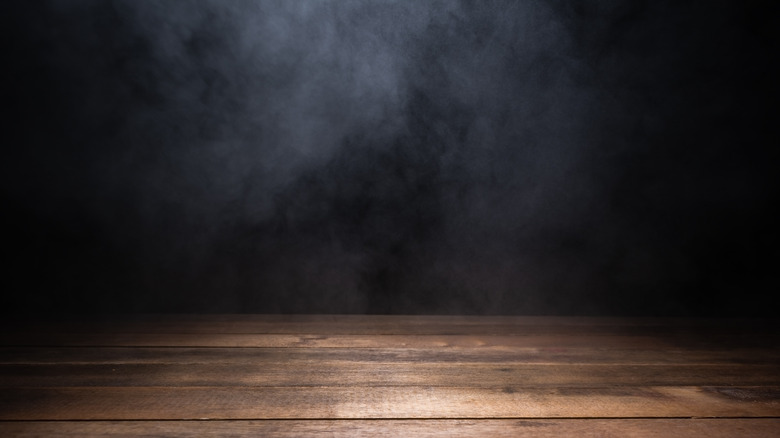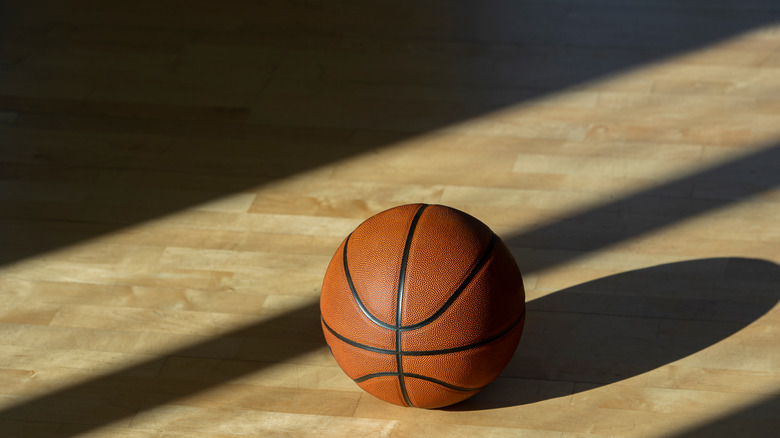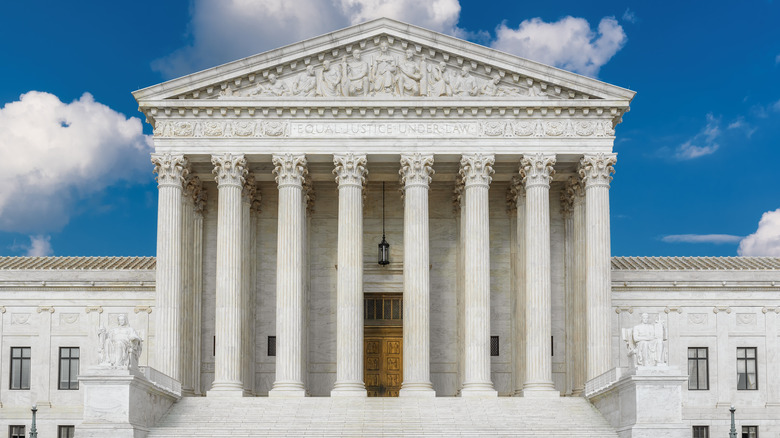The Surprising Room Above The Supreme Court
The thought of a government building's mystery room conjures images of thick soundproof walls and whispers of state secrets. This is not the case with the Supreme Court Building's fifth-floor room, placed right above the Supreme Courtroom (per Atlas Obscura). The signs hung throughout the fifth-floor hallways reveal the room's true purpose: "Playing basketball and weightlifting are prohibited while court is in session. DO NOT ASSUME COURT IS OVER!" (via the Salt Lake Tribune). That's right: a basketball court and weight room hide behind the historic building's triangular facade.
In addition to the stress-reducing communal space that it is, the aptly called "Highest Court in the Land" also provides endless dad jokes (per Atlas Obscura). For example, responding to an invitation to play H-O-R-S-E with some clerks, Justice Clarence Thomas once said, "You know, Supreme Court justices don't play H-O-R-S-E, they play habeas corpus" (per the Salt Lake Tribune).
While not open to the public, the court and gym serve as a place for building employees to sweat, play, and de-stress. Clerks, off-duty police officers, librarians, cafeteria workers, security guards, and even SCOTUS justices use the facility (via Atlas Obscura and Sports Illustrated).
Court Lore
The supreme basketball court produces bountiful lore about the justices' competitive and athletic habits. For example, the court's first woman justice, Sandra Day O'Connor — understanding the room's male-dominated culture — frequently reserved the room for aerobics classes, encouraging her female colleagues to attend (per Sports Illustrated). As context, while half of law students are women, twice as many men than women receive supreme court clerkships (via Sports Illustrated).
Approaches to literally evening the playing field have varied. Some female clerks like Renee Lettow Lerner (Justice Anthony Kennedy) refused to play with the all-male teams (per Sports Illustrated). In contrast, others joined their male colleagues, albeit with hesitation. Former clerk and civil-rights lawyer Penda Hair remembers, "I was conscious of the place of women in the building and in the legal profession. ... So I did not think that there should be an all-male basketball game" (via Sports Illustrated). Later, high school forward Robin Lenhardt, a clerk for Anthony Kennedy, thrived on the court (per Sports Illustrated).
Though athletics relieve stress, clerks and justices alike can't separate work and play, writes the Salt Lake City Tribune. Some law clerks have used their skilled rhetoric to debate fouls and calls. Former clerk Tom Lee recalls to the Salt Lake City Tribune that "you were living and breathing the Supreme Court. ... Even when you're playing basketball, you'd end up talking about the cases."
Was it always a basketball court?
The origin of "the highest court in the land" is unknown, Atlas Obscura reports. Cass Gilbert, the building's architect, intended the room for storage (per Sports Illustrated). After the building's completion in 1935, the room housed documents for the law library, spare chairs, tables, and files, the Salt Lake City Tribune writes. Then, sometime in the 1940s, the room was converted into a workout space for court employees. However, according to Sports Illustrated, the details around the conversion are unclear.
One of the earliest known people to use the room for fitness was Justice Hugo Black, who practiced tennis (per Sports Illustrated). Over time, basketball won out as the room's default sport. Wooden backboards and baskets were soon installed (via Atlas Obscura). Amateur athletes viewed the original cement floor, low ceiling, and close quarters as either annoying or endearing (per Sports Illustrated). Eventually, the court received an upgrade. Plexiglass backboards replaced the wooden ones in 1984. A 2015 remodel replaced the cement with a hardwood floor, boasting the supreme court eagle's image mid-court (via Sports Illustrated).
Even with its modern makeover, the sound from the gym — especially dribbling the ball — can get noisy. Mike Lee, a former clerk for Justice Samuel Alito, told the Salt Lake City Tribune, "People don't realize this, but it's immediately on top of the courtroom." Hence the need for plentiful signage warning players to avoid court hours.


